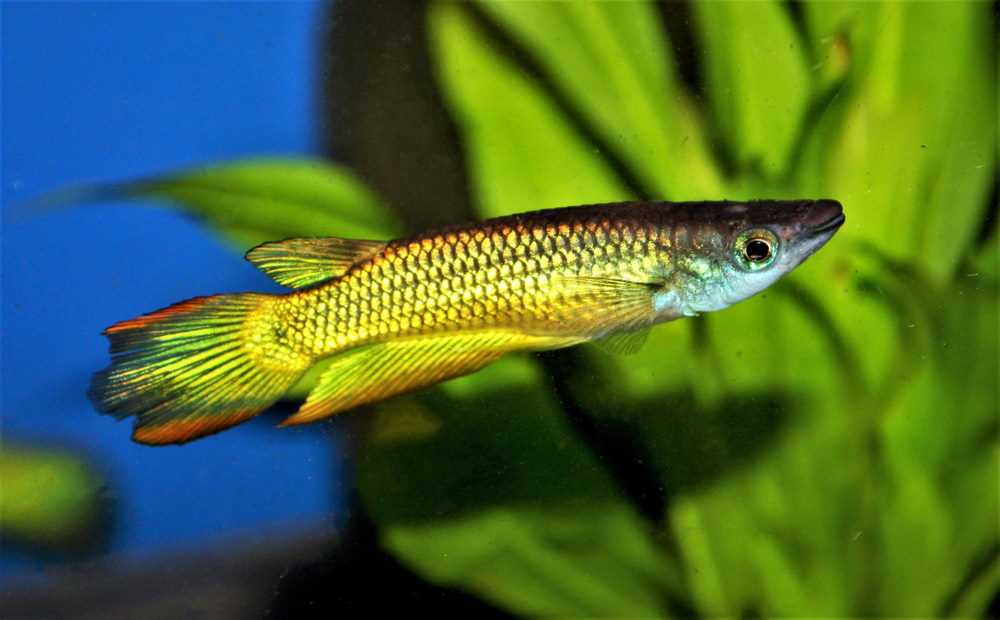Top 5 Colorful Killifish That Every Fish Keeper Should Try
Killifish are one of the most colorful fish in the freshwater aquarium hobby, but with such an amazing array of hues and patterns, why aren’t they as popular as livebearers or African cichlids? Many veteran fishkeepers will tell you that they are top-dwelling fish that love to jump out of the water, so you must have a close-fitting lid and cover even the smallest hole to prevent their escape. Also, annual killifish can be harder to keep because they only live for a few months after you hatch their eggs. Thankfully, not all species have such short lives, so to help you get started, we have compiled a list of our favorite killies that are easy to find, care for, and breed in your home aquarium.
1. Clown Killifish

Epiplatys annulatus
Coming in at a mere 1.4 inches (3.5 cm), the clown killi is the most petite killifish on our list and can live in nano tanks as small as 5 gallons. They are known as the “banded panchax” because of their distinct, vertical bands of dark brown and tannish-yellow, and they are also called the “rocket killifish” because the male has a striking, flame-like tail. As with most of the killifish in this article, they enjoy slightly cooler waters between 67–79°F (19–26°C) and may forgo an aquarium heater, depending on your room temperature.
We like to get a group of six clown killies — ideally two males and four females — so that we can breed them. Place a DIY spawning mop in the aquarium, and condition them for spawning by feeding lots of tiny foods like frozen cyclops, live baby brine shrimp, and nano pellets. Once you spot eggs in the mop, place the eggs in a breeding box or separate grow-out tank to prevent the adults from eating them. For more details, read our full care guide.
2. Orange Australe Killifish

Aphyosemion australe
This color variation of the lyretail panchax is recognized for its bold orange body, red spotting, and tail with extended tips. They grow up to 2.5 inches (6 cm) long, which means a pair of them can live in a 10- to 20-gallon aquarium. With a larger fish tank, multiple pairs and trios can be kept together. Because they have bigger mouths, they can easily eat bloodworms, Vibra Bites, frozen brine shrimp, and other meaty fish foods.
If you plan to keep your killies in a community aquarium with other tank mates, use a spawning mop to remove their eggs for hatching. However, if you put a colony of them in a species-only setup, just add some dense aquarium plants (e.g., floating water sprite and Pogostemon stellatus ‘octopus’) to hide the fry, and their numbers should naturally increase over time.
3. Gardneri Killifish

Fundulopanchax gardneri
It’s difficult to describe the kaleidoscope of colors embodied in this 2.5-inch (6 cm) fish because the males can range from a pale pink to blue-green to purple sheen with prominent red dots all over. We personally find them to be one of the easiest killies to spawn as long as you keep them in cooler temperatures, have a tight aquarium lid, and feed meaty foods. They have bigger mouths than you think and may even eat tiny fish, so don’t put them with smaller nano species. Males can be a bit feisty, so use lots of aquarium plants and taller decorations to break up line of sight and minimize aggression. The extra shelter will also help more babies to survive. Feed the fry plenty of live baby brine shrimp so that they will grow big and healthy, and you should have no problem selling these gorgeous killies to your local fish store or other hobbyists.
4. Blue Gularis Killifish

Fundulopanchax sjoestedti
The largest killi on our list grows to 4–5 inches (10–13 cm) in length, and they come with a big, ornery personality to match their size. The males are predominantly blue with dense clusters of red dots and vertical stripes, and their tails have an eye-catching orange band down the middle. To make sure the male does not bother the female too much, give a pair of these killies a 29-gallon aquarium or larger with plenty of aquatic plants and ornaments for cover. Much like the garderni killifish, this species is quite the meat lover and will happily consume bloodworms, brine shrimp, and even smaller nano fish. They may be a little harder to find, so trying sourcing them from fish stores, your local aquarium society, online retailers, and online auction sites like AquaBid.
5. Golden Wonder Killifish

Aplocheilus lineatus
This beautiful, golden-yellow fish is also a bigger killifish that reaches 3–4 inches (8–10 cm) in size. They are very active, not too expensive, and can live with medium-sized tank mates like bala sharks and blood parrot cichlids. Many big pet store chains like to sell them because of their hardiness and ability to live in a wide range of water parameters. As with the other larger killies, they enjoy a mostly carnivorous diet and will go after your nano fish and dwarf shrimp if they fit in their mouths.
Killifish are extremely colorful and rival the vibrancy of saltwater fish. Just be aware that they tend to live for about 2–5 years, depending on the species, so lower the temperature to extend their life span and keep passively breeding them to enjoy them for as long as possible. While we do not ship live fish, you can check out our list of preferred online retailers to see the latest fish they have in stock.




